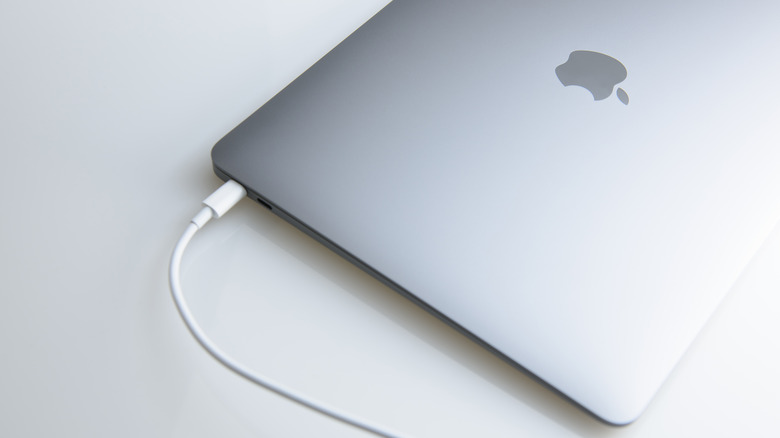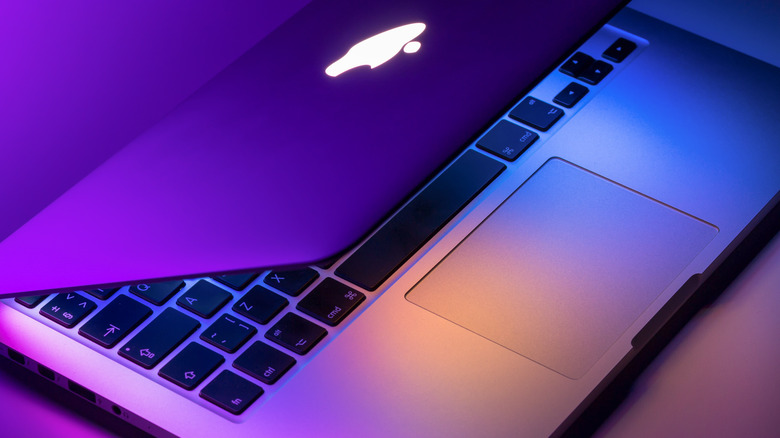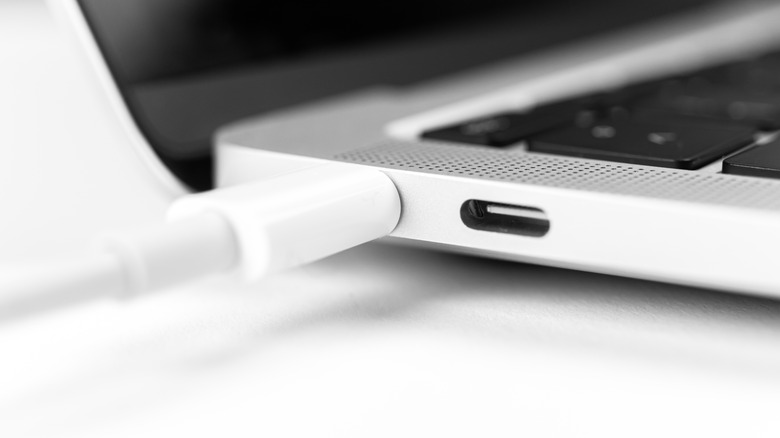Can You Charge Your MacBook With A Phone Charger?
For people who use a MacBook for school or work, one of the worst things that can happen is running out of battery when you have a pressing and important task you need to get through. If you have your laptop's charger with you and are in an area with a power outlet, this of course is not a hard issue to remedy because you can continue working while the MacBook is plugged in. However, what are your options if you don't have your MacBook charger handy? Can you use an iPhone charger or any phone charger for that matter?
Before you get yours, it's important to not only understand your particular MacBook's power-charging requirements but to also ensure that your laptop's charging port even matches any phone-charging cord or power adapter you have access to. If you happen to own an older MacBook that uses a power adapter with a magnetic connector — it's the kind that automatically positions itself into place when it's held close to the laptop charging port — then a phone charger will definitely not work. If, however, you have one of the newer MacBook models that uses a USB-C power adapter and charge cable, then you may have a variety of charging options.
How to identify your MacBook's wattage requirements
According to Apple, the most optimal way to charge any MacBook model is to use a power adapter that has the ability to produce the minimum wattage provided by the charger that came with your laptop. If you own another Apple product and have its Apple power adapter handy, you can quickly check it for compatibility through a label on it that lists its wattage capabilities. If the number on it matches or is higher than the wattage number that's on your MacBook's original charger, then you should be good to go. The most accurate way to check if the Apple power adapter you have is actually working is by plugging it into the laptop and checking your MacBook settings:
- While long-pressing the Option key, click on the Apple menu (it's the apple icon in the top-left of the screen) and choose System Information.
- From the left panel, go to the Hardware section.
- Choose Power.
You'll know if the Apple adapter you're currently using has enough power to juice up your MacBook by looking in the AC Charger Information section. Next to Charging, it should say Yes.
Charging options for USB-C-compatible MacBooks
If your MacBook came with an Apple brand USB-C power adapter, technically you can use any USB-C power adapter and a USB-C cable to charge it, including those used for non-Apple mobile devices. Of course, it goes without saying that using your MacBook's official charger and leaving it plugged in while the laptop is in use is the best way to ensure the device retains a battery charge. If you are in a pinch, you can certainly try using whatever USB-C power adapter you have on hand — whether it provides a higher or lower wattage than the original adapter that came with your Mac — and not worry that it will damage the battery.
However, it is important to note that if your phone charger's adapter provides a wattage lower than what your MacBook requires, it may take forever to charge or may not even work at all. Furthermore, when you do not use the official charger that came with it, your MacBook's ability to hold a charge for a long period of time is on a case-to-case basis and is often not a guarantee.
To ensure that your emergency third-party USB-C power adapter and cable combo is actually working to the best of its ability to charge your MacBook, connect it to your device and plug it into a power outlet and then go through the steps in the previous section to see if the machine is actually charging. If your MacBook's System Information doesn't provide any useful data — in some cases, it may not detect non-Apple chargers properly — you can try completely shutting down your laptop and leaving it plugged into a power source for as long as possible.


